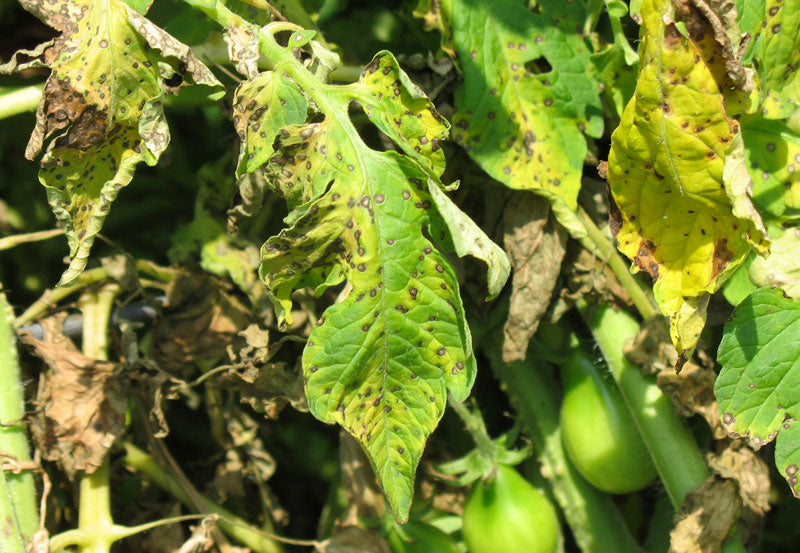
The Difference Between Early Blight, Late Blight, and Septoria Blight
Early blight is a common disease affecting plants, particularly those in the nightshade family such as potatoes and tomatoes. It's caused by a soil borne fungus called Alternaria solani. The name "early" does not imply that the disease occurs only early in the season, but does most commonly occur in the early season.

Symptoms of early blight usually start appearing on the lower, older leaves as small brown spots. These spots enlarge, often forming a pattern of concentric rings giving a "bull's-eye" appearance. The surrounding leaf area may turn yellow. If left uncontrolled, it can cause significant defoliation, usually starting at the base of the plant and moving upwards.
Early blight can also affect the fruits of the plant. On tomatoes, dark, sunken, leathery spots can form, usually at the point where the fruit is attached to the plant
Late blight is a serious and devastating plant disease caused by the pathogenic water mold Phytophthora infestans. It's most infamous for causing the Irish Potato Famine in the 1840s, but it also affects other plants in the nightshade family, such as tomatoes, peppers, and eggplants.

This pathogen prefers cool, damp, and humid conditions and can spread rapidly, especially in these environments. It is one of the few plant pathogens that can produce spores both asexually and sexually, leading to a great genetic diversity and adaptability.
Symptoms of late blight typically appear later in the growing season. Initial symptoms include irregularly shaped dark spots on leaves, often surrounded by a pale "halo". As the disease progresses, it may cause the entire plant to wilt and die. It can also cause dark, firm lesions on tubers and fruits.
Septoria leaf spot, also known as Septoria blight, is a common fungal disease that primarily affects tomatoes but can also occur on other plants. It is caused by the fungus Septoria lycopersici.

Septoria leaf spot usually appears on the lower leaves after the first fruit sets. The disease begins as small, water-soaked spots. These spots darken and enlarge to form circular or angular grey or tan areas that may be up to 1/4 inch in diameter. The center of these spots later turn white and tiny black specks, which are the fruiting bodies of the fungus, can often be seen in the white centers.
This disease does not typically affect the fruit directly, but by defoliating the plant, it can lead to sunscald on the fruit. Also, heavily defoliated plants will produce fewer, smaller fruit.
Prevention of blight
-
Plant Resistant Varieties: Breeding programs have developed potato and tomato varieties that are resistant to late blight. Always opt for these, if possible.
-
Healthy Seed Material: Use only certified, disease-free seed potatoes or seeds. The disease can be carried in infected tubers, seed potatoes, and tomato seeds.
-
Crop Rotation: Do not plant potatoes or tomatoes in the same spot where they or their relatives were grown in the past two years. This can help prevent the buildup of the pathogen in the soil.
-
Proper Spacing: Proper plant spacing can enhance air circulation around your plants, reducing humidity and making conditions less favorable for the pathogen.
-
Pruning: Pruning lower leaves will reduce splashing from the soil as well as increase airflow. Typically on tomatoes the recommended pruning height is around 12 inches.
-
Regular Monitoring: Regularly inspect your plants for signs of the disease. The earlier you detect it, the better your chances of managing it effectively.
-
Fungicide Application: Applying fungicides can help prevent the disease, especially if conditions are favorable for its development. Using your own fungicide from a homemade spray can often be just as effective as store bought on the home-garden scale. Here is a recipe that we use with great success!
2-3 Tablespoon baking soda
2 tablespoons olive oil
2-4 drops of dish soap
1 gallon water
Place ingredients in spray bottle and shake until combined and spray ONLY when sun is not peak. Early morning and night are best times to spray. -
Remove Infected Plants: If you find plants with late blight, remove them immediately to prevent the spores from spreading to other plants. You may compost or burn these plants; since blight spores are found in most soil, the nutrient value is worth more than the risk of additional blight.
-
Proper Sanitation: Clean your tools and hands after handling infected plants to avoid accidentally spreading the pathogen. You can clean your tools like pruners simply with a little rubbing alcohol.
Living in Missouri I start treating for these diseases early in the season using neem oil, soap, and baking soda. Does olive oil work the same as neem? Thank you for the information and great photos.
Thanks for info & recipe!
Been following your chan since you were in high school. Before the first sign your dad surprised you with! Love the info and personnel stories. Even shared your gas leak story to some other chans. You are often mentioned on quite a few!
Leave a comment